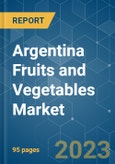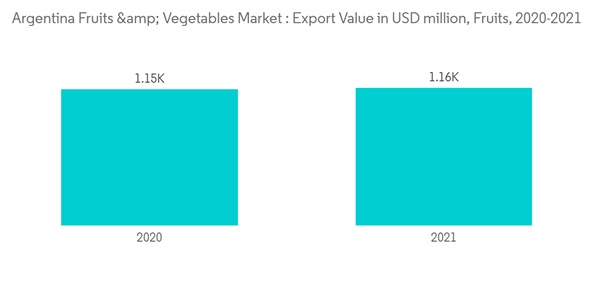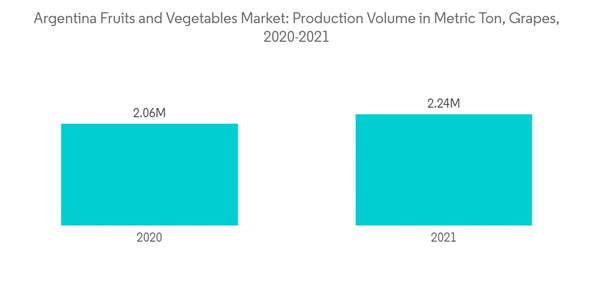Key Highlights
- Due to favorable weather conditions, the production of Argentina's most fresh and deciduous fruits, such as apples, pears, and grapes, increased tremendously in recent years. Domestic consumption of fresh fruits is also expected to grow due to a significant increase in production and the lack of competitiveness of local exporters in the international market.
- Fruits and vegetables are important supplements to the human diet as they provide the essential nutrients required for maintaining health. Argentina is one of the major producers of fruits and vegetables globally. It produces several horticultural crops like apples, bananas, oranges, pears, grapes, lemons, tomatoes, carrots, onions, chili, and pumpkins.
- Argentina's economic problems in the past decade have led to reduced profitability in the sector, resulting in the area gradually declining in the major fresh fruit and vegetable growing regions of Argentina. Besides the lack of profitability affecting most fruit producers, grape producers face water scarcity, which also affects fruit prices in the country.
- However, improving farming techniques through increasing investment by public and private companies in the market is expected to drive the development of the fruits and vegetables market in the country. Several companies are investing in greenhouse farming techniques to increase the production of fruits and vegetables and thereby improve the domestic supply to satiate the growing demands of consumers.
Argentina Fruits and Vegetables Market Trends
Increasing government initiative to boost the production and Export
- The government of Argentina extensively supports the production of fruits and vegetables. The ultimate goal of the Argentinian government is to support its regional rural economies and to boost the production and export of fresh produce. In March 2020, the government announced adjustments to its export tax regime, according to which the tax rate for the export of most of the fruit and vegetable produce was 5%.
- The removal of export taxes significantly impacted the international markets, making the county's fresh produce highly competitive. In addition, the government established a 7.0% export rebate for most of the fresh and deciduous fruits shipped from the ports of Buenos Aires. The export taxes adjustment on many specialty crops, including apples, pears, citrus fruits, blueberries, seeds, and alfalfa, intended to improve the international competitiveness of these products.
- The government provided funds to the provinces of Rio Negro and Neuquen for various programs related to plant health issues to increase production. The Government of Argentina also supports the fruit sector under the Agricultural Emergency Law by providing tax deferrals to struggling producers, among other benefits. With the new government administration, exports are gradually reaching their previous levels, expected to drive the fruits and vegetable market during the forecast period.
Grapes to Dominate the Argentine Fresh Produce Sector
- Grape production in Argentina was reported at 2,055.7 thousand metric tons in 2020 and 2,241.4 thousand metric tons in 2021. The terroir of Argentina is unique compared to the rest of the world and differs slightly around the country. Being located next to the mountains offers Mendoza the benefit of high altitude.
- Not only does this translate to direct sunlight, but the snow from the Andes is a great source of clean, pure water that can hydrate the vines. Additionally, the high altitude makes it difficult for viruses and fungal diseases to survive on vines, allowing for increased cultivation and better grape yields annually.
- Besides protecting from phylloxera, rootstocks confer resistance to nematodes and salinity and can control the vines' vigor in the vineyard. Consequently, more vineyards in Argentina are planted with grafted vines, especially in Mendoza's newer and more sophisticated growing regions. The market attractiveness of grapes, especially in the form of raisins and fresh juices, will likely intensify fresh grape production in the coming years.
- Grapes offer many health benefits, including lowering blood pressure, improving memory and mood, and protecting against infections. The major driving factor of the production is the increasing consumption of grape products owing to the rising awareness about its health benefits and improving demand for wine.
Argentina Fruits and Vegetables Industry Overview
Additional Benefits:
- The market estimate (ME) sheet in Excel format
- 3 months of analyst support
This product will be delivered within 2 business days.










